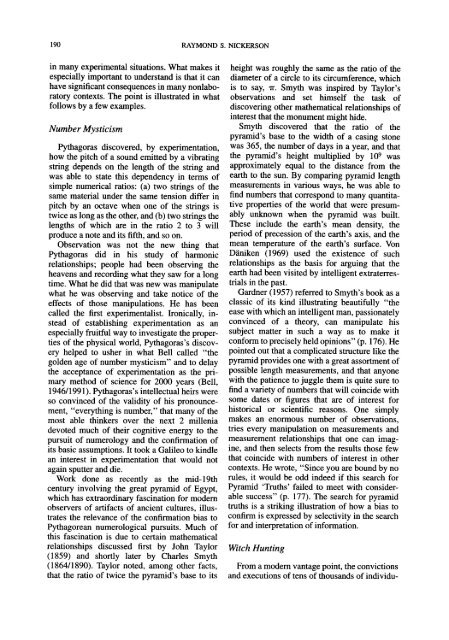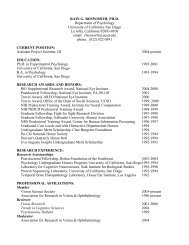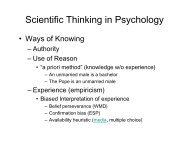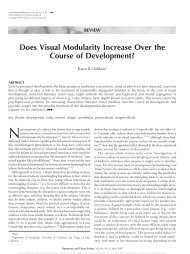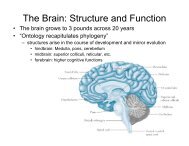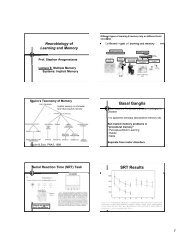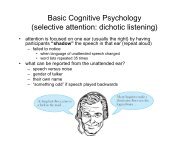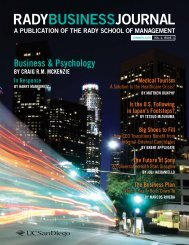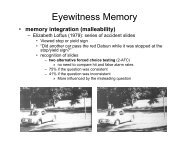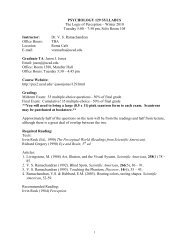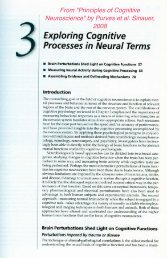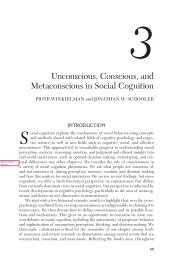Confirmation Bias: A Ubiquitous Phenomenon in Many Guises
Confirmation Bias: A Ubiquitous Phenomenon in Many Guises
Confirmation Bias: A Ubiquitous Phenomenon in Many Guises
Create successful ePaper yourself
Turn your PDF publications into a flip-book with our unique Google optimized e-Paper software.
190 RAYMOND S. NICKERSON<br />
<strong>in</strong> many experimental situations. What makes it<br />
especially important to understand is that it can<br />
have significant consequences <strong>in</strong> many nonlaboratory<br />
contexts. The po<strong>in</strong>t is illustrated <strong>in</strong> what<br />
follows by a few examples.<br />
Number Mysticism<br />
Pythagoras discovered, by experimentation,<br />
how the pitch of a sound emitted by a vibrat<strong>in</strong>g<br />
str<strong>in</strong>g depends on the length of the str<strong>in</strong>g and<br />
was able to state this dependency <strong>in</strong> terms of<br />
simple numerical ratios: (a) two str<strong>in</strong>gs of the<br />
same material under the same tension differ <strong>in</strong><br />
pitch by an octave when one of the str<strong>in</strong>gs is<br />
twice as long as the other, and (b) two str<strong>in</strong>gs the<br />
lengths of which are <strong>in</strong> the ratio 2 to 3 will<br />
produce a note and its fifth, and so on.<br />
Observation was not the new th<strong>in</strong>g that<br />
Pythagoras did <strong>in</strong> his study of harmonic<br />
relationships; people had been observ<strong>in</strong>g the<br />
heavens and record<strong>in</strong>g what they saw for a long<br />
time. What he did that was new was manipulate<br />
what he was observ<strong>in</strong>g and take notice of the<br />
effects of those manipulations. He has been<br />
called the first experimentalist. Ironically, <strong>in</strong>stead<br />
of establish<strong>in</strong>g experimentation as an<br />
especially fruitful way to <strong>in</strong>vestigate the properties<br />
of the physical world, Pythagoras's discovery<br />
helped to usher <strong>in</strong> what Bell called "the<br />
golden age of number mysticism" and to delay<br />
the acceptance of experimentation as the primary<br />
method of science for 2000 years (Bell,<br />
1946/1991). Pythagoras's <strong>in</strong>tellectual heirs were<br />
so conv<strong>in</strong>ced of the validity of his pronouncement,<br />
"everyth<strong>in</strong>g is number," that many of the<br />
most able th<strong>in</strong>kers over the next 2 millenia<br />
devoted much of their cognitive energy to the<br />
pursuit of numerology and the confirmation of<br />
its basic assumptions. It took a Galileo to k<strong>in</strong>dle<br />
an <strong>in</strong>terest <strong>in</strong> experimentation that would not<br />
aga<strong>in</strong> sputter and die.<br />
Work done as recently as the mid-19th<br />
century <strong>in</strong>volv<strong>in</strong>g the great pyramid of Egypt,<br />
which has extraord<strong>in</strong>ary fasc<strong>in</strong>ation for modern<br />
observers of artifacts of ancient cultures, illustrates<br />
the relevance of the confirmation bias to<br />
Pythagorean numerological pursuits. Much of<br />
this fasc<strong>in</strong>ation is due to certa<strong>in</strong> mathematical<br />
relationships discussed first by John Taylor<br />
(1859) and shortly later by Charles Smyth<br />
(1864/1890). Taylor noted, among other facts,<br />
that the ratio of twice the pyramid's base to its<br />
height was roughly the same as the ratio of the<br />
diameter of a circle to its circumference, which<br />
is to say, IT. Smyth was <strong>in</strong>spired by Taylor's<br />
observations and set himself the task of<br />
discover<strong>in</strong>g other mathematical relationships of<br />
<strong>in</strong>terest that the monument might hide.<br />
Smyth discovered that the ratio of the<br />
pyramid's base to the width of a cas<strong>in</strong>g stone<br />
was 365, the number of days <strong>in</strong> a year, and that<br />
the pyramid's height multiplied by 10 9 was<br />
approximately equal to the distance from the<br />
earth to the sun. By compar<strong>in</strong>g pyramid length<br />
measurements <strong>in</strong> various ways, he was able to<br />
f<strong>in</strong>d numbers that correspond to many quantitative<br />
properties of the world that were presumably<br />
unknown when the pyramid was built.<br />
These <strong>in</strong>clude the earth's mean density, the<br />
period of precession of the earth's axis, and the<br />
mean temperature of the earth's surface. Von<br />
Daniken (1969) used the existence of such<br />
relationships as the basis for argu<strong>in</strong>g that the<br />
earth had been visited by <strong>in</strong>telligent extraterrestrials<br />
<strong>in</strong> the past.<br />
Gardner (1957) referred to Smyth's book as a<br />
classic of its k<strong>in</strong>d illustrat<strong>in</strong>g beautifully "the<br />
ease with which an <strong>in</strong>telligent man, passionately<br />
conv<strong>in</strong>ced of a theory, can manipulate his<br />
subject matter <strong>in</strong> such a way as to make it<br />
conform to precisely held op<strong>in</strong>ions" (p. 176). He<br />
po<strong>in</strong>ted out that a complicated structure like the<br />
pyramid provides one with a great assortment of<br />
possible length measurements, and that anyone<br />
with the patience to juggle them is quite sure to<br />
f<strong>in</strong>d a variety of numbers that will co<strong>in</strong>cide with<br />
some dates or figures that are of <strong>in</strong>terest for<br />
historical or scientific reasons. One simply<br />
makes an enormous number of observations,<br />
tries every manipulation on measurements and<br />
measurement relationships that one can imag<strong>in</strong>e,<br />
and then selects from the results those few<br />
that co<strong>in</strong>cide with numbers of <strong>in</strong>terest <strong>in</strong> other<br />
contexts. He wrote, "S<strong>in</strong>ce you are bound by no<br />
rules, it would be odd <strong>in</strong>deed if this search for<br />
Pyramid 'Truths' failed to meet with considerable<br />
success" (p. 177). The search for pyramid<br />
truths is a strik<strong>in</strong>g illustration of how a bias to<br />
confirm is expressed by selectivity <strong>in</strong> the search<br />
for and <strong>in</strong>terpretation of <strong>in</strong>formation.<br />
Witch Hunt<strong>in</strong>g<br />
From a modern vantage po<strong>in</strong>t, the convictions<br />
and executions of tens of thousands of <strong>in</strong>dividu-


